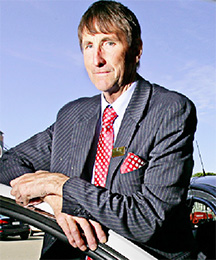MELBOURNE, (Reuters) – Phillip Hughes’ fight for survival from a severe head injury has prompted a wave of sympathy across the globe, not least from former New Zealand cricketer Ewen Chatfield, who was nearly killed by a fast delivery in the 1970s.
Chatfield played 43 tests, ending his international career in 1989, but his debut against England 14 years earlier remains memorable for all the wrong reasons.
A fast bowler and by his own admission, a typically hopeless number 11 batsman, 24-year-old Chatfield was facing England paceman Peter Lever, who fired a short-pitched ball that cannoned off his glove and into his temple.
“I just went to the side of the wicket and sat down and then I don’t remember anything after that until I woke in the ambulance on the way to the hospital,” Chatfield, now 64, told Reuters yesterday.
After collapsing unconscious, Chatfield twitched and moaned before help arrived in the form of England physiotherapist Bernard Thomas, who had been in the stands but bolted onto the field when he heard players yelling.
Chatfield had swallowed his tongue and his heart had stopped. With no medical equipment at the ground, Thomas administered CPR to revive him and likely kept him alive before an ambulance arrived to whisk him to hospital.
“If it hadn’t been for Bernard Thomas, the English team physiotherapist, I probably wouldn’t be speaking to you today,” said Chatfield, now a taxi driver in the New Zealand capital of Wellington.
“I suppose I must count myself lucky to be here but it was more traumatic for the players. Peter Lever, I understand, was very distraught about the whole thing and thought that he’d killed somebody and no bowler wants that resting over him.”
ABBOTT SYMPATHY

For that reason, Chatfield’s heart went out to Sean Abbott, the 22-year-old Australian all rounder whose short-pitched ball struck his former team mate Hughes in the head and left him in an induced coma in a Sydney hospital.
“He may never get over it. I hope he does,” he said.
“Obviously he’s a good player and you’d hate for his career to be cut off at a young age.”
Things were different in the 1970s. Where Hughes wore a helmet and was unlucky to be struck in the back of the head, Chatfield had only a mop of hair for protection.
New Zealand lacked a team doctor or physiotherapist at the ground. A worker for St John, a local charity that provides first aid, was there but Chatfield said he was an “elderly chap”.
“By the time he got out there, things mightn’t have been so rosy,” he said.
As Hughes remained in critical condition at St Vincent’s hospital on Wednesday, Abbott and Australia’s domestic cricketers received counselling. Sports psychologists were in short supply back in Chatfield’s day.
After a night in hospital, he was released and though he missed the last few weeks of the season, he was back at it later in the year, bringing a helmet, still a frivolous adornment for many batsmen of the time.
The blow never haunted Chatfield for the rest of his 14-year international career.
“I had confidence enough that if I did get hit in the head — and I did a few times after that — I’d just gone out there and done my best,” he said.
“The wickets are probably a lot better (today). They used to play on damp wickets and so the ball used to do all sorts of things. But I think today you’d be silly if you didn’t wear a helmet.”

